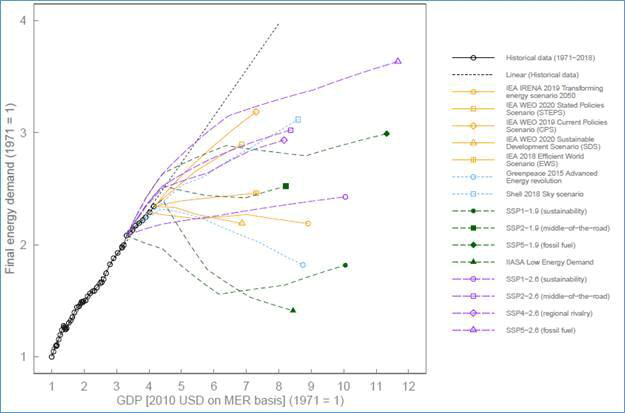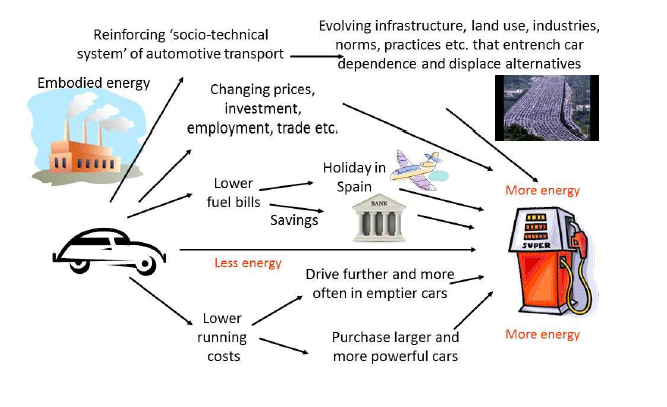Improving the energy efficiency of everything from the lights in people’s homes to the cars they drive is a key component of global climate action.
Such efficiency gains, which are included in many influential computer models, can lower energy use and, therefore, make it easier to decarbonise the global economy.
At the same time, they can improve quality of life, boost productivity, increase competitiveness and contribute to growing the economy.
However, counterintuitively, gains in energy efficiency can also encourage behavioural change towards more energy use, meaning some of the anticipated energy savings may be “taken back”. This is known as the “rebound effect”.
In a new paper, published in Renewable and Sustainable Energy Reviews, we examine the economy-wide impact of these effects and find they may erode more than half of the potential energy savings from improved energy efficiency.
We also find that these rebound effects are not adequately included in the global energy and climate models used by organisations, such as the Intergovernmental Panel on Climate Change (IPCC) and the International Energy Agency (IEA), which means they may underestimate the future growth of global energy demand.
As a result, there is a risk that global climate action relies too heavily on energy savings that may not materialise.
Climate scenarios require unprecedented decoupling
Historically, GDP and energy use have been closely linked. Evidence suggests that energy demand typically increases as economies grow, while restricted access to energy can limit economic growth.
Between 1971 and 2015, global GDP rose by an annual average of 3.1% as global primary energy use rose by 2.1% each year. This is known as “relative decoupling”, where both variables increase but GDP increases faster than energy use.
Organisations such as the IPCC use “integrated assessment models” (IAMs) to answer questions about climate change and changes in the future energy system. Similar models have been developed by the IEA and other organisations.
Most of these scenarios project little or no growth in global energy use over the next few decades, due to a combination of structural change, such as deindustrialisation and improved energy efficiency throughout the global economy.
Several of these scenarios anticipate near-term “absolute decoupling”, where GDP rises while energy use falls. This is despite the need for large-scale investment in energy-intensive infrastructure and heavy industry in developing countries.
This greater level of decoupling can be seen in the chart below, which shows GDP plotted against the world’s final energy demand – that is to say, the total energy consumed by end users. Energy demand falls in some of these scenarios while GDP increases, indicating absolute decoupling.
However, there is no historical precedent for absolute decoupling at the global level – and only limited experience at a national level.

Historical trends and future scenarios for global final energy use and GDP from 1971 to 2050. Scenarios are divided into four groups: International Energy Agency models (orange), green 1.5C integrated assessment models (IAMs – green), 2C IAMs (purple) and other models (blue). SSPs are “shared socioeconomic pathways”, which are used by modellers to examine how global society, demographics and economics might change over the next century. The Shell 2018 Sky scenario sets a pathway to meet the “well-below 2C” goal of the Paris Agreement. Source: Brockway, P.E. et al. (2021).
Growing evidence of large rebound effects
A possible reason for the close links between energy use and GDP in the past is the presence of large “rebound effects” – a variety of economic shifts that offset some of the energy savings from improved energy efficiency.
For example, energy efficient lighting saves energy, but also makes lighting cheaper, which, in turn, encourages people to light up larger areas to higher levels over longer periods of time.
Widespread adoption of energy-efficient lighting may also bring down the price of electricity, which could further encourage increased consumption.
Another example, namely a more fuel-efficient car, is illustrated in the figure below, with examples of the direct and indirect pathways that can lead to increased energy use.

Illustration of rebound effects resulting from a more fuel-efficient car. Source: Sorrell, S. et al. (2018).
The economy-wide rebound effect is the net result of multiple adjustments of this type throughout a nation or the world.
It is usually expressed as the percentage of the energy savings that would be achieved if none of those adjustments occurred. A 0% rebound means that all of the potential energy savings are achieved, while a 100% rebound means that all of these savings are “taken back”.
Economy-wide rebound effects are extremely difficult to measure, but the evidence has grown substantially over the past decade.
In our paper, we reviewed 21 studies that used ‘computable general equilibrium‘ (CGE) models to estimate the size of these effects from a variety of energy-efficiency improvements in different countries and sectors.
These CGE model studies gave a mean estimate of 58% rebound, with a median estimate of 55%, implying that more than half of the potential energy savings from the modelled efficiency improvements were not achieved.
We also surveyed 12 studies that used a variety of other methods to estimate economy-wide rebound effects and found a mean estimate of 71% rebound.
In total, more than two-thirds of the studies found rebound effects larger than 50%. Six found rebound effects of 100% or more, implying that in some instances the energy savings may be eliminated altogether.
The studies varied widely in terms of methods used and types of improvement investigated, and their results were often sensitive to uncertain assumptions.
Nevertheless, taken as a whole, they provide a consistent message of economy-wide rebound effects eroding more than half of the potential energy savings from improved energy efficiency.
Examining models
A key question is whether these rebound effects are properly factored into global energy models.
To explore this, we examined four of the IAMs used by the IPCC, together with the models used by BP, Shell, the IEA and the US Energy Information Administration (EIA).
We found that most of these models relied upon external assumptions for key variables and were unable to capture many of the mechanisms contributing to rebound effects.
Two of the models (REMIND and MESSAGE-GLOBIOM) included more detailed modelling of the macro-economy, but did so in a simplified manner that left out important mechanisms such as changes in the relative size of different sectors.
Moreover, several of the models calibrated the magnitude of energy-efficiency improvements to an assumed outcome for energy consumption, rather than modelling the impact those improvements actually had on consumption. This precludes the investigation of rebound effects.
We conclude that these models could result in global energy scenarios overestimating the potential for energy savings and underestimating future global energy demand.
Implications for climate action
We do not question the importance of improved energy efficiency, since it can deliver multiple economic benefits alongside real energy savings.
However, we do have concerns about the current realism of key global climate scenarios.
If efficiency-based energy savings are smaller than anticipated, the world may need to rely more heavily upon a low-carbon energy supply, carbon capture and storage and negative emission technologies to meet its climate goals.
Energy sufficiency and economic degrowth are also strategies that could come more sharply into focus.
Additionally, there is scope for using economy-wide carbon pricing to mitigate rebound effects and to increase energy savings, alongside spending the revenues on low-carbon investments.
It may also be possible to target energy-efficiency policy at sectors and technologies that offer the potential for larger economic benefits alongside smaller rebounds.
Most importantly, our research highlights the urgent need for the modelling community to take rebound effects more seriously, and to find ways of incorporating the full range of rebound mechanisms into their global energy models.
Without this, the plausibility of global energy scenarios – and particularly those with absolute decoupling – is open to question.
Brockway, P. E. et al. (2021) Energy efficiency and economy-wide rebound effects: a review of the evidence and its implications, Renewable and Sustainable Energy Reviews, doi.org/10.1016/j.rser.2021.110781
Teaser photo credit: Photo by Denys Nevozhai on Unsplash





